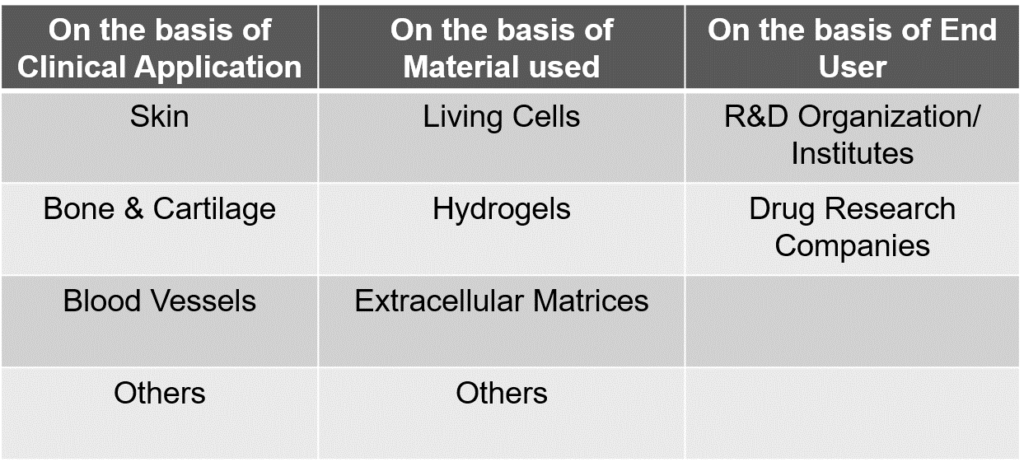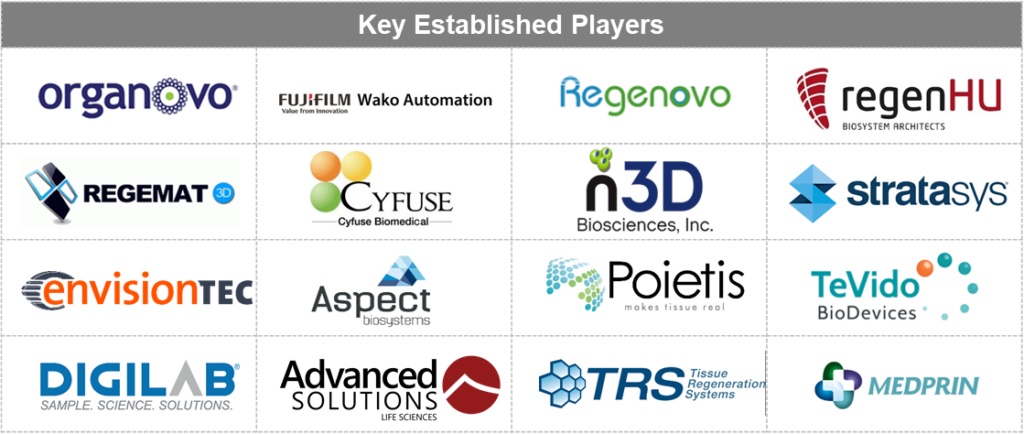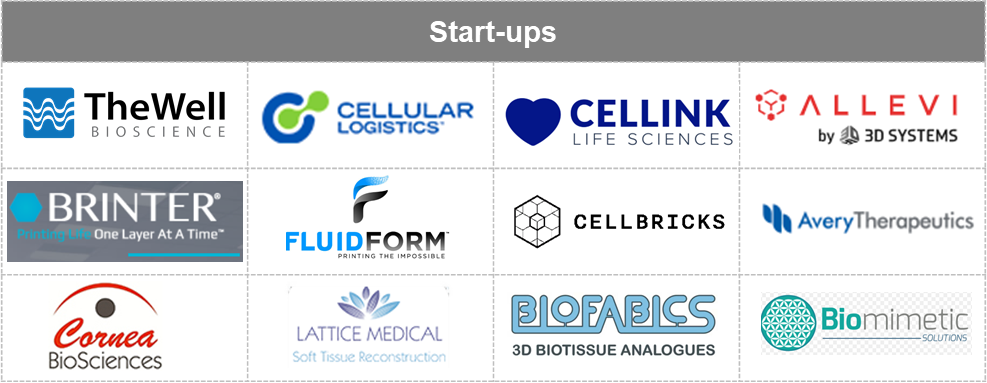Regenerative Medicine is primarily an outcome of utilizing tissue engineering, stem cell therapies, and artificial 3D printed organs to amplify the natural healing processes in the body or replace a permanently damaged organ. Bringing in together the expertise of various fields including genetics, biology, biochemistry, information technology and robotics, regenerative medicine seeks to accelerate the healing process of the human body.
Bioinks for Scaffold
The development of bioinks has proven to be the cornerstone of 3D bioprinting technology. Polymeric scaffolds used in tissue engineering exhibit certain prominent characteristics, including:
- Appropriate surface-holding properties for the promotion of cell adhesion, proliferation, and differentiation
- High biocompatibility
- High ratio of surface-area-to-volume and interconnected pore network for cell growth and improved flow of nutrients
- Sufficient mechanical properties to combat in vivo stresses
Smart and Natural Biomaterials
Smart biomaterials have the capacity to transform numerous fields, such as regenerative medicine and tissue engineering, and are currently undergoing rapid development.
The expansion of smart biomaterials’ potential clinical applications is anticipated to enhance patients’ health and quality of life, thereby ensuring their significance in the realm of regenerative medicine and tissue engineering.
Chitosan is the most abundant natural biopolymer. Moreover, its biocompatibility, biodegradability, and anti-bacterial properties make it preferable for cell-cell adhesion. Other natural biopolymers contain silk, collagen, hyaluronic acid, etc.
Researchers utilize new biomaterials engineered from natural sources, such as marine sponges and decellularized tissues (cartilage), to mimic the biophysical and biochemical characteristics of native tissues. This approach reduces the likelihood of immune rejection. Researchers tailor other natural polymers, such as gelatin and alginate, to co-encapsulate cells and therapeutics, thereby guiding cellular functions.

Smart bioinks include formulations of sodium alginate (NaAlg)/Poly(N-Isopropylacrylamide) (PNIPAm)/ZnSO4-based bioinks, wherein PNIPAm act as a smart polymer and resembles any biocompatible ECM. Decellularized Extracellular Matrix (dECM) provides a non-cellular component of tissue that shows fine compatibility and osteogenic capacity.
Fig 1: Scaffolds
3D Bioprinting Technology
3D Bioprinting allows one to recreate tissues, organs, and microenvironments, utilizing several biomaterials and naturally derived bio-inks.

A combination of multifunctional materials with different therapeutic approaches provides a microenvironment resembling a native extra-cellular matrix. The therapeutic approaches can include gene delivery (that promotes vascularization), immunomodulatory agents (that help overcome implant rejections and promote tissue healing), and nanomaterials that provide additional mechanical stimulus or energy.
Fig 2: Schematic Overview of the 3D Bioprinting Process

3D Bioprinting has several promising avenues in the area. It precisely solves several technical hurdles in the field, such as allowing a high level of control and precise positioning of several cell types and enabling accurate recapitulation of tissue/organ microstructure with high architectural complexity. 3D bioprinting is responsive to faster automation and is a scalable technique resulting in the mass production of tissues/organs.
Table 1: Types of 3D Printers and Bioinks
Regenerative Medicine: Current Market Scenario

By 2024, the 3D bioprinting market is projected to reach a value of USD 1,647.4 million, with the highest growth rate expected in the skin printing application segment. The key driver of the industry is the focus on technological advancements in the fabrication of artificial tissues and organs. Also, several countries have been developing a supportive regulatory environment that will drive the growth of the stem cell and regenerative medicine industry.
Table 2: Differentiation of Market Share
Regenerative Medicine: Key Actors in the Field
Understanding the appropriate bioprinting techniques to mitigate vascularization, cell incorporation, mechanical performance, and structural integrity issues is urgently needed.

- Organovo, based in the US, is pioneering in the field of 3D bioprint tissues. It mimics key aspects of human biology and disease. ExVive™ 3D is an automated bioprinting process resulting in scalable tissues and 3D Bioprinted Human Liver Tissue with distinct hepatocellular (HC) and non-parenchymal cell (NPC) compartments.
- Regenovo Biotechnology Co., Ltd. is a Chinese high-tech enterprise. It provides biomedical 3D printer equipment, materials and software for regenerative medicine, tissue engineering, drug discovery, and personalized medical applications.
- Cyfuse’s Bio 3D Printer aims to put 3D cellular products into practical use as regenerative medical products to regenerate various tissues and organs.
- Poietis provides a next-gen bioprinting platform to bring tissue engineering therapies into the market.
Regenerative Medicine: Exemplary Commercial Products
Medical professionals have developed a few grafts utilizing their knowledge and expertise in the field of tissue engineering. It provides tissue-engineered solutions.
- Avery Therapeutics’ leading product, MyCardia™ is a stable and robust allogeneic engineered tissue graft. Researchers use it in pre-clinical studies of heart failure.
- Manufacturers can produce these grafts at scale, cryopreserve them, and ship them at 4°C.
- Lattice Medical develops a guided bio-absorbable adipose tissue reconstruction solution for breast regeneration, MATTISSE.
- Cornea Biosciences treats corneal blindness using tissue engineering, wherein the bio-engineered cornea is made from Type III recombinant human collagen cross-linked with biopolymers.

Current Scenario – Bioscaffolds
- US-based Cellular Logistics is commercializing an acellular biomaterial using its biomaterial platform, Tandem™, enabling cardiac cell therapies.
- R&D firm Biofabics specializes in the generation and culture of 3D Biotissue Analogs. Moreover, researchers create these products by combining cells extracted from the host body with 3D-printed biomaterials.
- Biomimetic Solutions develops high-quality nanomaterials for tissue engineering applications to be further used in clinical trials and cell therapies for treating damaged or recovering tissues.
How Do Smart Biomaterials Enhance Tissue Regeneration?
Smart biomaterials have the potential to enhance tissue regeneration by reacting to various environmental factors like temperature, pH, ionic concentration, light, and electric and magnetic fields. Also, this ability allows them to influence cell behavior and tissue formation. Moreover, these biomaterials can be customized to display specific biological functions, including promoting tissue in-growth, vascularization, and nutrient passing. Additionally, they can be designed as absorbable scaffolds that are naturally broken down by the host’s metabolic activity.
Recent research has made significant advancements in developing innovative smart scaffold constructs to enhance the effectiveness of tissue regeneration. These intelligent biomaterials cannot only facilitate the delivery and guidance of stem cells for improved tissue regeneration but also enable controlled releases of drugs and bioactive agents in a spatially and temporally controlled manner.
In addition, biofilms can be modulated or suppressed to combat infections in wound sites. Smart biomaterials can react to external stimuli, such as mechanical forces, electrical or magnetic fields, temperature, pH, and enzymatic changes, to initiate a specific response or behavior. For instance, polymers that respond to mechanical stimuli, biomaterials containing superparamagnetic iron oxide nanoparticles that respond to magnetic fields, and biomaterials that respond to acoustic stimuli have demonstrated promise in the field of bone regeneration.
Recent Advancements in Smart Biomaterials and Regenerative Medicine
Smart biomaterials play a crucial role in regenerative medicine by facilitating tissue repair and regeneration through their ability to respond to environmental factors and precisely release stem cells, drugs, and bioactive agents.
- Hard tissue repair and regeneration: Smart biomaterials, like bone and tooth structures, possess the potential to revolutionize hard tissue repair and regeneration with a considerable global economic impact. Also, these materials can be engineered to stimulate tissue in-growth, vascularization, and nutrient transfer and can be metabolized by the host’s metabolic processes.
- Responsive materials: Smart biomaterials of the latest generation can react to external stimuli, including mechanical forces, electric or magnetic fields, temperature, pH, and enzymatic changes, to initiate specific responses or behaviors. Additionally, these materials are suitable for various tissue engineering applications, including bone regeneration.
- Stem cell guidance and delivery: Smart biomaterials can guide and deliver stem cells to improve tissue regeneration. They can also be designed to release drugs and bioactive agents in a spatially and temporally controlled manner, promoting tissue repair and regeneration.
- Wound site management: Advanced biomaterials have the ability to regulate and inhibit biofilms, as well as fight off infections in wound sites, leading to enhanced wound healing.
Conclusion
In the advancement of 3D bioprinting for future prospects, the development of bio-scaffolds, with chitosan as the most commonly used material, has emerged as the primary requirement. Currently, new biomaterials such as marine sponges and decellularized cartilages are being preferred. Further, smart bioinks are widely used, wherein formulations such as PNIPAm resemble ECM. US-based Organovo is the market leader in this domain with the ExVive™ platform, resulting in scalable tissues and 3D Bioprinted Human Liver Tissue. Also, Cellular Logistics (US) has been focusing on commercializing a cellular biomaterial Tandem™ platform that enables cardiac cell therapies.
In accordance with the above factors, the 3D bioprinting market is slated to grow much faster. Its key focus will remain on skin printing applications. Moreover, just like precision medicine, regenerative medicine technology is expanding rapidly.